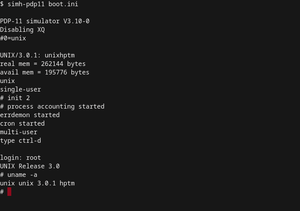
Back Unix Afrikaans UNIX ALS Unix AN يونكس Arabic Unix AST Unix Azerbaijani Unix BAR UNIX BAT-SMG Unix Byelorussian UNIX BE-X-OLD
 | |
 Unix System III running on a PDP-11 simulator | |
| Developer | Ken Thompson, Dennis Ritchie, Brian Kernighan, Douglas McIlroy, and Joe Ossanna at Bell Labs |
|---|---|
| Written in | C and assembly language |
| OS family | Unix |
| Source model | Historically proprietary software, while some Unix projects (including BSD family and illumos) are open-source |
| Initial release | Development started in 1969 First manual published internally in November 1971[1] Announced outside Bell Labs in October 1973[2] |
| Available in | English |
| Kernel type | Varies; monolithic, microkernel, hybrid |
| Influenced by | CTSS,[3] Multics |
| Default user interface | Command-line interface and Graphical (Wayland and X Window System; Android SurfaceFlinger; macOS Quartz) |
| License | Varies; some versions are proprietary, others are free/libre or open-source software |
| Official website | www |
| Internet history timeline |
|
Early research and development:
Merging the networks and creating the Internet:
Commercialization, privatization, broader access leads to the modern Internet:
Examples of Internet services:
|
Unix (/ˈjuːnɪks/ ⓘ, YOO-niks; trademarked as UNIX) is a family of multitasking, multi-user computer operating systems that derive from the original AT&T Unix, whose development started in 1969[1] at the Bell Labs research center by Ken Thompson, Dennis Ritchie, and others.[4] Initially intended for use inside the Bell System, AT&T licensed Unix to outside parties in the late 1970s, leading to a variety of both academic and commercial Unix variants from vendors including University of California, Berkeley (BSD), Microsoft (Xenix), Sun Microsystems (SunOS/Solaris), HP/HPE (HP-UX), and IBM (AIX).
The early versions of Unix—which are retrospectively referred to as "Research Unix"—ran on computers like the PDP-11 and VAX; Unix was commonly used on minicomputers and mainframes from the 1970s onwards.[5] It distinguished itself from its predecessors as the first portable operating system: almost the entire operating system is written in the C programming language (in 1973), which allows Unix to operate on numerous platforms.[6] Unix systems are characterized by a modular design that is sometimes called the "Unix philosophy". According to this philosophy, the operating system should provide a set of simple tools, each of which performs a limited, well-defined function.[7] A unified and inode-based filesystem and an inter-process communication mechanism known as "pipes" serve as the main means of communication,[4] and a shell scripting and command language (the Unix shell) is used to combine the tools to perform complex workflows.
Version 7 in 1979 was the final widely released Research Unix, after which AT&T sold UNIX System III, based on Version 7, commercially in 1982; to avoid confusion between the Unix variants, AT&T combined various versions developed by others and released it as UNIX System V in 1983. However as these were closed-source, the University of California, Berkeley continued developing BSD as an alternative. Other vendors that were beginning to create commercialized versions of Unix would base their version on either System V (like Silicon Graphics's IRIX) or BSD (like SunOS). Amid the "Unix wars" of standardization, AT&T alongside Sun merged System V, BSD, SunOS and Xenix, soldifying their features into one package as UNIX System V Release 4 (SVR4) in 1989, and it was commercialized by Unix System Laboratories, an AT&T spinoff.[8][9] A rival Unix by other vendors was released as OSF/1, however most commercial Unix vendors eventually changed their distributions to be based on SVR4 with BSD features added on top.
AT&T sold Unix to Novell in 1992, who later sold the UNIX trademark to a new industry consortium called The Open Group which allow the use of the mark for certified operating systems that comply with the Single UNIX Specification (SUS). Since the 1990s, Unix systems have appeared on home-class computers: BSD/OS was the first to be commercialized for i386 computers and since then free Unix-like clones of existing systems have been developed, such as FreeBSD and the combination of Linux and GNU, the latter of which have since eclipsed Unix in popularity. Unix has been, until 2005, the most widely used server operating system.[10] However in the present day, Unix distributions like IBM AIX, Oracle Solaris and OpenServer continue to be widely used in certain fields.[11][12]
- ^ a b McIlroy, M. D. (1987). A Research Unix reader: annotated excerpts from the Programmer's Manual, 1971–1986 (PDF) (Technical report). CSTR. Bell Labs. 139. Archived (PDF) from the original on 11 November 2017.
- ^ Ritchie, D. M.; Thompson, K. (1974). "The UNIX Time-Sharing System" (PDF). Communications of the ACM. 17 (7): 365–375. CiteSeerX 10.1.1.118.1214. doi:10.1145/361011.361061. S2CID 53235982. Archived (PDF) from the original on 11 June 2015.
- ^ Ritchie, Dennis M. (1977). The Unix Time-sharing System: A retrospective (PDF). Tenth Hawaii International Conference on the System Sciences. Archived (PDF) from the original on June 11, 2015. Retrieved September 26, 2024.
a good case can be made that [UNIX] is in essence a modern implementation of MIT's CTSS system
- ^ a b Ritchie, D.M.; Thompson, K. (July 1978). "The UNIX Time-Sharing System". Bell System Tech. J. 57 (6): 1905–1929. CiteSeerX 10.1.1.112.595. doi:10.1002/j.1538-7305.1978.tb02136.x. Retrieved December 9, 2012.
- ^ Schwartz, John (June 11, 2000). "Microsoft's Next Trials". The Washington Post. Archived from the original on December 13, 2024. Retrieved December 17, 2024.
- ^ Ritchie, Dennis M. (January 1993). "The Development of the C Language" (PDF). Archived (PDF) from the original on 11 June 2015. Retrieved 30 July 2022.
- ^ Raymond, Eric (19 September 2003). The Art of Unix Programming. Addison-Wesley. ISBN 978-0-13-142901-7. Archived from the original on 12 February 2009. Retrieved 9 February 2009.
- ^ Computerworld, GARY ANTHES of; IDG (July 27, 2009). "Timeline - 40 Years Of Unix - NYTimes.com". archive.nytimes.com. Retrieved December 4, 2024.
- ^ Lewis, Peter H. (June 12, 1988). "Is Unix's Time Finally at hand?". The New York Times. Archived from the original on February 5, 2011. Retrieved December 17, 2024.
- ^ Bangeman, Eric (February 22, 2006). "Windows passes Unix in server sales". Ars Technica. Retrieved December 5, 2024.
- ^ Garvin, Skip (September 19, 2019). "Top IBM Power Systems myths: "IBM AIX is dead and Unix isn't relevant in today's market" (part 2)". IBM Blog. Retrieved December 5, 2024.
- ^ "Unix is dead. Long live Unix!".